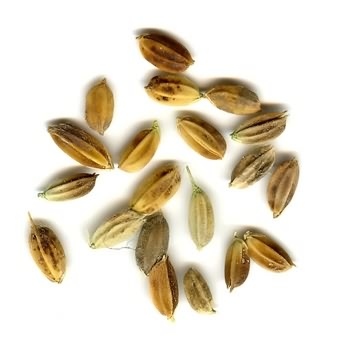Diseases
Fusarium graminearum Schwabe, Teleomorph - Gibberella zeae (Schwein.) Petch - Head Blight of Rice
Systematic position.
Division Eumycota, subdivision Deuteromycotina, class Hyphomycetes, order Tuberculariales, family Tuberculariaceae, genus Fusarium. Teleomorph - division Ascomycota, order Hypocreales, family Hypocreaceae, genus Gibberella.Synonyms.
Gibberella saubinetii (Mont.) Sacc., Fusarium roseum Link.Biological group.
These are hemibiotrophic parasites.Morphology and biology.
Head Blight disease of rice is caused by different species of Fusarium, of which F. oxysporum f. oryzae dominates in the majority of regions, and F. moniliforme dominates in the Primorskii Territory. However F. graminearum is the most harmful for man and animals, producing mycotoxins and causing the disease "intoxicating bread". The fungus causes the formation of spots on the surface of glumes which become white at first, but yellow, salmon, or carmine later. Infected grains are light, shrunken, and brittle; they can have reddish appearance or brown spots. Stem nodes become black, rot and disintegrate. Stems wilt, break, and lodge. Sporodochia, conidial masses and blue-black ascomata may be observed on infected glumes. Perithecia are also formed at nodes of infected stems. Perithecia are superficial, forming clusters, ovoid and 140-250 microns in diameter. Asci are 60-85 x 8-11 microns, clavate. Ascospores are hyaline to light-brown, curved, fusiform, with rounded apices, 3-septate, 19-24 x 3-4 microns. Macroconidia are produced on dolioform conidiogenous cells, forming laterally on hyphae or on short multi-branched solitary conidiophores. Sporodochia can form in older cultures. Macroconidia are falcate, 3-7 septate, 25-50 x 3-4 microns, with a well developed stem cell. Microconidia are absent. Chlamydospores intercalary, single or located in chains or clumps, globose, thick-walled, hyaline to pale brown, 10-12 microns in diameter. Primary inoculum source infests crop residues, where ascospores and conidia are released from, infesting seeds. The fungus survives in rice seeds for more than 13 months.Ecology.
Infection is favored by high temperatures (25-30.C) and high relative humidiy (85% and more).Distribution.
This species is distributed throughout the Rostov Region, Caspian Depression, Krasnodar Territory, Dagestan, the Far East, Kazakhstan, Uzbekistan and Tajikistan.Economic significance.
Germinating capacity of infected seeds decreases by 2-3 times. The fungus produces mycotoxins, contaminating grains ("intoxicating bread"). Control measures are as follows: Optimal agronomical measures, maintenance of crop rotation, cultivation of relatively resistant cultivars, careful removal of plant residues, separating seeds from shrunken grains, treatment of seeds before sowing by fungicides, treatment of crops by fungicides during vegetation period.Reference citations:
Ainsworth G.C. 1971. Ainsworth & Bisby's Dictionary of the fungi. Sixth edition. Kew, Surrey: Commonwealth Mycological Institute. 663 p.Baimataeva B.K., Kuzhantaeva Zh.Zh. 1978. Fungal diseases of rice. Bulletin of agricultural science of Kazakhstan (Alma-Ata), 3: 86-88. (In Russian)
Begunov I.I. 1992. Fusarium diseases of rice and its control in Kuban' region. In: Goncharov V.T., ed. Fusarium diseases of cereals. Proceedings of the scientific-coordinative meeting; Oct 19-22, 1992; Krasnodar. Krasnodar: Soviet Kuban'. 42 p.
Berdysh Yu.I. 2004. Distribution of main pests and diseases of crops in Krasnodar Territory in 2003 and prognosis of its incidence in 2004. Krasnodar: STAZR. 28 p. (In Russian)
Dorofeeva L.L., Sizova T.P., Shapovalova R.A. 1993. Phytopathologic state of rice crops in Central Asia. Mikologiya i fitopatologiya, 27 (3): 62-66. (In Russian)
Egorova L.N., Oksenyuk G.I. 1989. Mycoflora of rice in Primorskii Territory. In: Reifman V.G., Dyakonov K.P., eds. Plant protection in the Far East. Vladivostok: Far Eastern branch of Academy of Science of USSR. 66-71 p. (In Russian)
Egorova L.N., Oksenyuk G.I., Blokhina M.V. 1986. Mycoflora of rice seeds in Primorskii Territory. In: Vasil'eva L.N., Azbukina Z.M., Egorova L.N., eds. Flora and systematics of spore plants in the Far East. Vladivostok: Far Eastern Scientific Center of Academy of Sciences of USSR. 106-125 p.
Hawksworth D.L., Kirk P.M., Sutton B.C., Pegler D.N. 1995. Ainsworth & Bisby's Dictionary of the fungi. 8th edition. Kew, Surrey: Commonwealth Mycological Institute. 616 p.
Kazantseva T.P., Sorokin N.S., Vasil'eva I.A., Dolgova T.M., Martynov A.Ya., Gavrilova E.A., Bakalova G.A., Logvinenko T.S., Bespalova A.P., Chichikhina T.V., Dolaberidze S.D., Artokhin K.S., Makhota V.M. 1997. Prognosis of incidence and distribution of pests, diseases of crops, weeds and quarantine objects on the territory of Rostov Region in 1997 and measures of control. Rostov-na-Donu: Yug. 128 p. (In Russian)
Maglakelidze A.I., Tikhonova N.A., Lebedev V.B. 1991. Fungal diseases of rice in Dagestan. Zashchita rastenii, 10: 8-9. (In Russian)
Mironenko P.V. 1960. Fusarium wilt of rice in Caspian Depression. Proceedings of All-Union research institute of plant protection, 14: 123-128. (In Russian)
Petrova A.I. 1976. The methodic directions on identification and protection of rice against Fusarium root rot. Leningrad: VIZR. 21 p. (In Russian)
© Gasich E.L.


